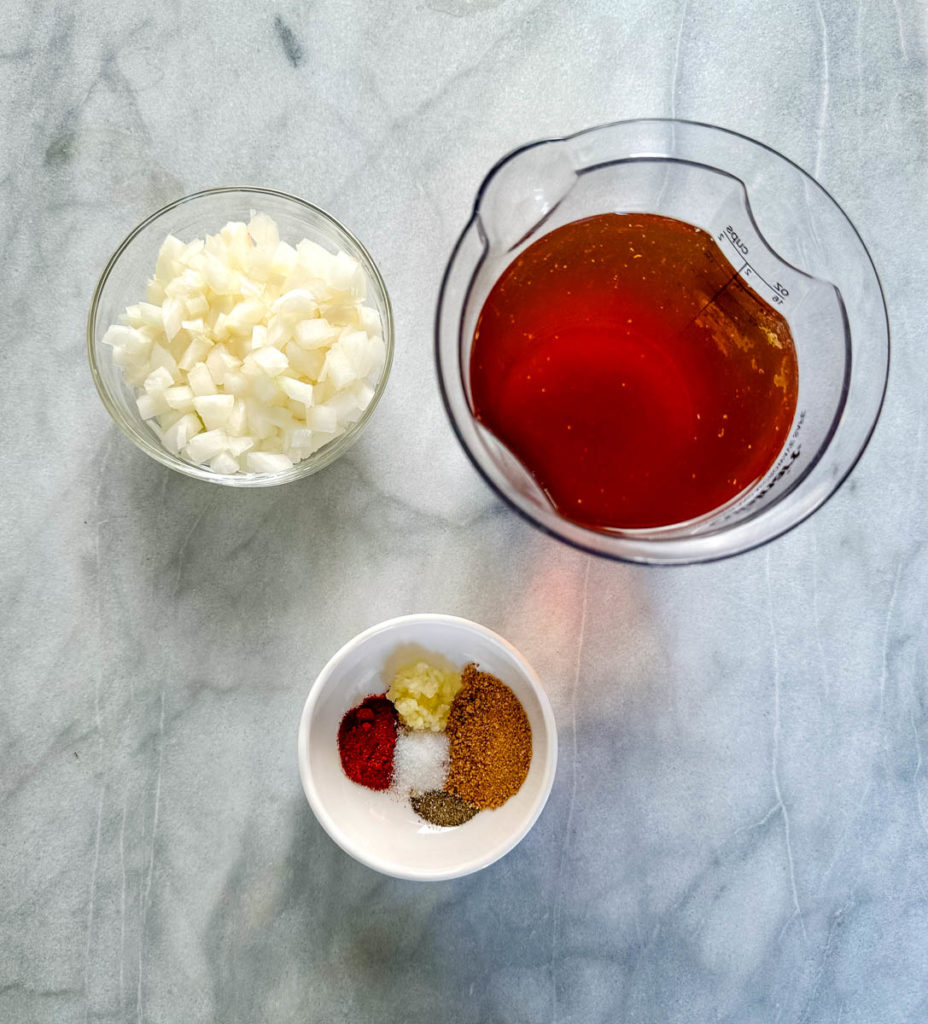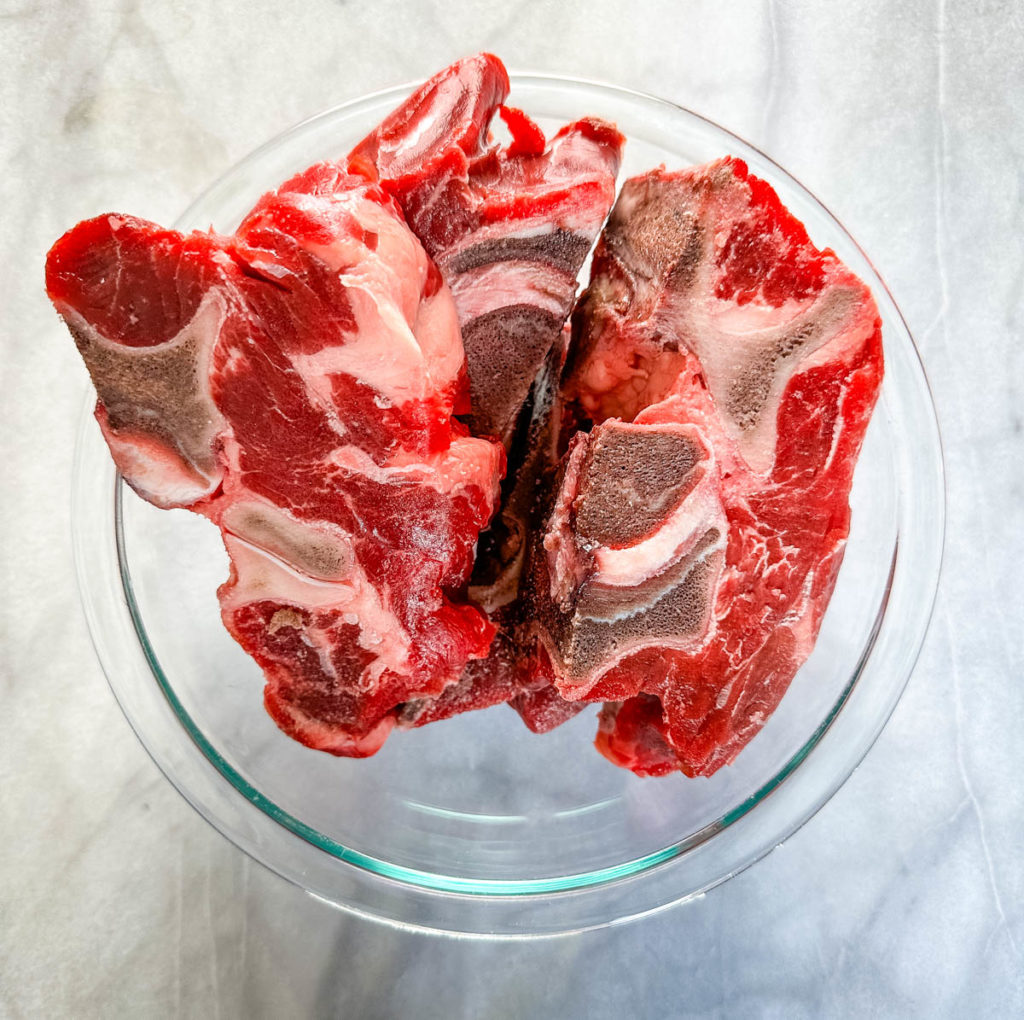This Southern Beef Neck Bones recipe is a family favorite. It is cooked on the stove until the meat falls off the bones. Pair this with rice, greens, or cornbread. You may also love our Pork Neck Bones.
Neck bones are a popular ingredient in many classic Southern dishes. But an important question remains – are neck bones pork or beef?
In this guide, we’ll break down the differences between pork and beef neck bones We’ll look at their origins, nutritional value, culinary uses, and how to tell them apart when dining on delicious Southern cuisine
The Animal Origins of Neck Bones
First, let’s clarify what neck bones actually are. Neck bones come from the cervical vertebrae of various animals, most commonly pork or beef.
Pork neck bones come from the neck of a pig. They tend to be smaller and more delicate than beef neck bones.
Beef neck bones come from the neck of a cow and tend to be larger and meatier.
Both offer that quintessential neck bone flavor perfect for soups, stews, gravies, and more. But there are some key differences between pork and beef that impact their use.
Nutritional Profile of Pork vs Beef Neck Bones
When it comes to nutrition, pork and beef neck bones have some similarities and differences:
-
Protein – Pork neck bones contain slightly more protein than beef, with 25g vs 20g per 3 oz serving
-
Fat & Calories – Beef neck bones contain more fat and calories – around 250 calories and 15g fat vs 200 calories and 10g fat in pork.
-
Vitamins & Minerals – Both are good sources of iron, zinc, and B vitamins. But beef contains more collagen.
Overall, pork neck bones tend to be leaner while beef packs more of a nutrient punch. But both make excellent additions to any Southern-inspired meal.
Culinary Uses for Neck Bones
Now let’s explore how pork and beef neck bones are used in the kitchen:
-
Braising – This moist-heat cooking method tenderizes tough cuts like neck bones into fall-off-the-bone perfection. Both pork and beef neck bones shine when braised.
-
Soups & Stews – Simmering neck bones adds rich body and flavor to soups and stews. Pork gives a lighter broth while beef is bolder.
-
Roasting – Roast pork or beef neck bones in the oven until lightly browned and tender. Pork may cook slightly quicker than beef.
-
Frying – Coat neck bones in seasoned flour and fry for a crispy, flavorful appetizer. Pork bones tend to get crunchier than beef when fried.
So while beef neck bones may require slightly longer cooking times, both pork and beef work beautifully in dishes calling for neck bones.
Popular Pork Neck Bone Dishes
Here are just a few classic Southern recipes that traditionally use pork neck bones:
-
Soul food greens – Pork neck bones give just the right flavor to collard greens, mustard greens, turnip greens, and cabbage.
-
Bean soups – Pork neck bones add body to hearty bean soups like pinto bean soup, white bean soup, and chickpea soup.
-
Neck bones and gravy – Braised pork neck bones smothered in rich, meaty gravy is a comforting Southern staple.
-
Fried neck bones – Crispy fried pork neck bones make a delicious, crunchy appetizer when paired with sauces for dipping.
Popular Beef Neck Bone Dishes
Meanwhile, here are some traditional Southern dishes that use beef neck bones:
-
Hearty stews – Beef neck bones create incredibly rich and flavorful beef stews when braised with veggies and broth.
-
Vegetable soup – For a meatier veggie soup, add cubed beef neck bones to the pot with carrots, potatoes, tomatoes and spices.
-
Pot roast – Braised beef neck bones transform into pull-apart tender meat perfect for pot roast sandwiches and platters.
-
Oxtail soup – This comforting Jamaican soup features tender oxtails (tail bones) and beef neck bones simmered in broth.
So while pork may be more common, beef neck bones still have a place in Southern cuisine.
How to Tell Pork vs Beef Neck Bones Apart
If you ever need to distinguish pork from beef neck bones, here are a few tips:
-
Size – Beef neck bones tend to be larger while pork bones are more petite and delicate.
-
Shape – Pork neck bones have more of a curved, oval shape while beef is straighter.
-
Meat – Beef bones often have more meat surrounding them compared to pork.
-
Fat – You’ll see more visible fat marbled throughout beef neck bones.
-
Color – Pork bones generally have a lighter color while beef bones are darker red.
So if you see small, curved bones with minimal meat, chances are you have pork neck bones. Large, straight bones with lots of fat and meat indicate beef.
The Takeaway on Neck Bones
While both pork and beef neck bones have a place in Southern cooking, pork tends to be the more traditional choice. The lean yet flavorful meat plays well in classic soul food dishes, stews, soups and gravies.
However, beef neck bones shouldn’t be overlooked either. Their hearty, beefy flavor can transform vegetables soups and stews.
No matter which you choose, neck bones add a kick of flavor and nutrition to any Southern-inspired meal. So embrace these bony beauties and enjoy exploring the culinary versatility of pork and beef neck bones!

Where to Buy Them
You may find packages of neck bones with little to no meat, which are mostly bones. Pay close attention and look for packages with meatier bones.
I find them readily available in local grocery stores. You can also check specialty markets, even some Asian grocery stores.


What Are Neck Bones
Beef neck bones are the meat and bone from the neck of a cow. They have a small amount of meat on them and when simmered, the meat is tender and juicy. In soul food meals, neck bones are often served with collard greens and southern cornbread. They are very cheap.


Cooking With Mama P Beef Neckbones and Gravy
FAQ
What animal is neck bones made from?
Are beef neck bones safe to eat?
Is smoked neck bone beef?
Do people eat pork neck?
What is a pork neck bone?
You may also love our Pork Neck Bones. Beef neck bones are the meat and bone from the neck of a cow. They have a small amount of meat on them and when simmered, the meat is tender and juicy. Neck bones are very inexpensive and are often served for soul food meals along with Collard Greens and Southern Cornbread.
What type of meat is good for bones?
However, the type of meat that is best for the bones depends on the cooking method and cut of the meat. Lean meats such as chicken and fish are good options for bone health. Additionally, lean red meats such as beef and pork can also be beneficial for bones if cooked using healthy methods such as grilling or roasting.
Should you eat pork neck bones?
Neck bones, like any other meat, are best eaten in the context of a balanced diet. If eaten in moderation and bought from respectable producers that prioritize health over industrialization, then they have even more nutrients and can be considered a good addition to your diet. Some important minerals in pork neck bones include [ * ].
What are neck bones?
Look no further than neck bones! These humble cuts of meat are a hidden gem in the culinary world. With their rich, savory taste, they can elevate any dish from ordinary to extraordinary.
